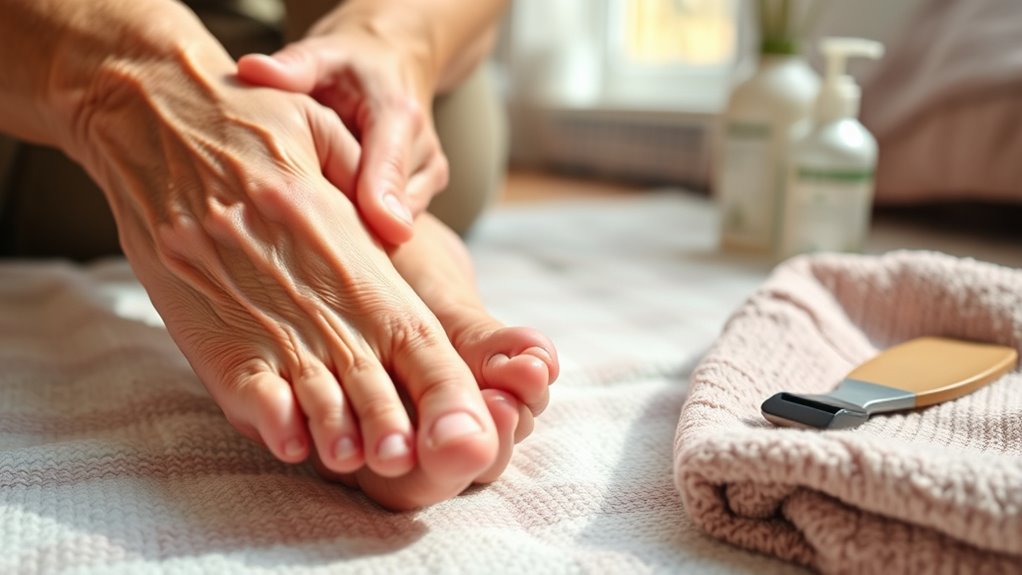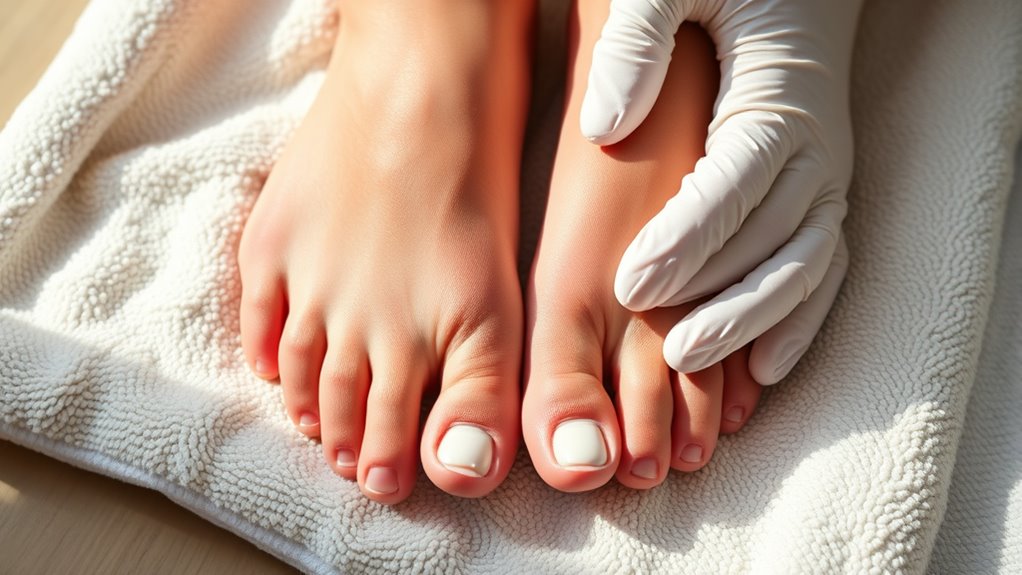To keep your feet healthy and pain-free, choose supportive, well-fitting shoes with breathable materials and good traction. Practice daily foot hygiene, inspect your feet regularly for cuts or swelling, and moisturize to prevent dryness. Incorporate gentle exercises and massages to boost circulation. If you have diabetes or foot problems, see a podiatrist promptly. Staying proactive about foot care helps you stay active and comfortable—continue for more tips on maintaining foot health as you age.
Key Takeaways
- Choose well-fitting, supportive shoes with good traction and breathability to prevent discomfort and foot injuries.
- Inspect feet daily for cuts, blisters, redness, or swelling, and maintain proper hygiene with gentle washing and thorough drying.
- Keep feet moisturized to prevent dry skin but avoid between toes to reduce infection risk.
- Perform regular foot exercises and massage to improve circulation and flexibility.
- Seek professional podiatric care for persistent pain or abnormalities to maintain foot health and mobility.

As you age, taking proper care of your feet becomes essential to maintaining mobility and overall health. Your feet bear the weight of your body every day, and over time, they can become more vulnerable to issues like pain, sores, or infections. If you have diabetes, paying extra attention to diabetic foot health is vital, since high blood sugar levels can impair circulation and nerve function, increasing the risk of unnoticed injuries or infections. That’s why choosing proper footwear is so important—well-fitting shoes can prevent blisters, calluses, and pressure points that might otherwise lead to serious problems.
Proper footwear is essential to prevent foot problems, especially for those with diabetes.
When selecting footwear, focus on comfort and support. Look for shoes that fit well, with enough room in the toe box to wiggle your toes freely. Shoes that are too tight can cause friction and lead to blisters or corns, while those that are too loose may cause your feet to slide, increasing the risk of falls. Opt for shoes with sturdy soles that provide good traction, which helps prevent slips and falls. Avoid high heels or shoes with narrow or pointed toes, as they can compress your toes and cause deformities over time. Proper footwear choices also mean choosing shoes made from breathable materials, like leather or mesh, to keep your feet dry and reduce the risk of fungal infections.
Keeping your feet clean and dry is another essential aspect of foot care. Wash your feet daily with gentle soap and warm water, then thoroughly dry them, especially between the toes. Moisture trapped in these areas can foster bacteria or fungi, leading to infections. Applying a moisturizer can help prevent dry, cracked skin, but avoid putting lotion between your toes, as excess moisture there can cause problems. Regularly inspecting your feet is key—look for cuts, blisters, redness, swelling, or any unusual changes. If you notice anything concerning, don’t delay seeking medical advice. Early intervention can prevent minor issues from becoming serious.
In addition to proper footwear, consider routine foot exercises to improve circulation and flexibility. Rotating your ankles, stretching your toes, or gently massaging your feet can boost blood flow and keep your feet more resilient. Incorporating self-massage techniques into your daily routine can further enhance circulation and relaxation. Using self-watering methods for foot care products or hygiene routines can help maintain consistent cleanliness and moisture levels, especially for those with limited mobility. Incorporating specialized foot care products, such as moisturizing creams designed for dry or cracked skin, can further support healthy foot skin. Regular foot inspections and proper hygiene are essential for preventing infections, especially in seniors and those with underlying health conditions. Developing a daily foot care routine that includes crochet styles for locs, while not directly related to foot health, exemplifies how engaging in creative activities can promote overall well-being and reduce stress. If you have existing foot problems or experience persistent pain, consult a podiatrist who can provide specialized care and guidance. Maintaining good foot hygiene, wearing supportive shoes, and monitoring your foot health regularly will all contribute to keeping your feet pain-free and functional as you age. Remember, healthy feet are the foundation of an active, independent life.
Frequently Asked Questions
How Often Should Seniors See a Podiatrist?
You should see a podiatrist at least once a year to maintain healthy feet, especially if you have diabetes or other foot concerns. Regular check-ups help guarantee proper footwear choices and shoe fitting, preventing issues like blisters or deformities. If you notice pain, numbness, or changes in your feet, don’t wait—schedule an appointment sooner. Routine visits keep your feet comfortable and healthy as you age.
Are There Specific Foot Exercises Recommended for Seniors?
Imagine your feet as the foundation of your daily life; keeping them strong is essential. You should try simple foot exercises like balance training and toe stretches regularly. These activities help improve flexibility and strength, reducing pain and risk of falls. Incorporate them into your routine, ideally daily or a few times a week. Staying active with these exercises keeps your feet healthy and pain-free, supporting your independence.
What Are Signs of Serious Foot Infections in Seniors?
You should watch for signs of infection in your feet, like increased redness, swelling, or warmth. Foot discoloration that doesn’t fade might also be a warning sign. If you notice persistent pain, open sores, or pus, seek medical help immediately. These symptoms indicate a serious foot infection that needs prompt treatment to prevent complications. Regular foot checks can help catch problems early and keep your feet healthy.
Can Seniors Safely Use Over-The-Counter Foot Creams?
Think of your feet as the foundation of a house; keeping them healthy is essential. When considering over-the-counter options, foot cream safety becomes key. You can safely use many OTC foot creams, but it’s wise to check ingredients and consult with a healthcare professional first. Some creams contain fragrances or chemicals that might cause irritation or allergic reactions, especially for seniors. Always read labels carefully and choose products designed for sensitive skin.
How Can Seniors Prevent Foot Ulcers and Sores?
To prevent foot ulcers and sores, you should practice good diabetic foot care and follow nail trimming tips carefully. Keep your feet clean and dry, check daily for cuts or blisters, and avoid walking barefoot. Wear well-fitting shoes, and regularly inspect your feet for signs of trouble. If you notice any issues, consult your healthcare provider promptly to prevent complications and maintain healthy feet.
Conclusion
Taking care of your feet is like tending a delicate garden—you need to nurture and protect it daily. By inspecting, moisturizing, and wearing proper shoes, you keep pain at bay and your steps steady. Remember, healthy feet are the foundation for an active life, helping you move comfortably through each day. With a little attention, you’ll keep your feet happy and your spirits high, ready to walk confidently into the future.









